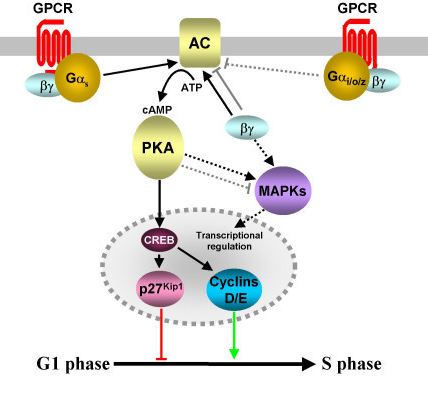Hi-Affi™ cAMP-activated GPCR Cell Lines
In currently days, G-protein coupled receptors (GPCRs) represent one class of the most popular therapeutic targets. To accelerate and simplify research of GPCR biology and drug discovery, Creative Biolabs has established an innovative Hi-Affi™ platform, which offers a comprehensive portfolio of over 50 GPCR stable cell lines designed to detect GPCR signaling through second messenger activation (e.g. Ca2+, cAMP, DAG). Meanwhile, we are always happy to tailor custom cell lines to meet specific demands and expectations.
cAMP Signaling Pathway
In the area of molecular biology, cAMP-dependent pathway (also known as the adenylyl cyclase pathway) is a GPCR-triggered signaling cascade that plays a critical role in cell communication. Adenylyl cyclases (AC) belongs to a family of enzyme that catalyses the conversion of adenosine triphosphate (ATP) to pyrophosphate and 3',5'-cyclic AMP (cAMP). cAMP is one of the important second messengers in GPCR pathway.
Adenylate cyclase can be activated or inhibited by G proteins that are coupled to membrane receptors, thus can respond to hormonal and many other stimuli. Following activation of adenylate cyclase, cAMP will increase and acts as a second messenger by interacting with or directly regulating other proteins like cyclic nucleotide-gated ion channels and protein kinase A (PKA). It is evidenced that a lot of different cellular responses are mediated by cAMP, e.g. heart rate increase, cortisol secretion, breakdown of glycogen and fat, etc. Dysfunction of cAMP-dependent pathway will probably lead to cell over-proliferation, which may contribute to the development and/or progression of the tumor.
 Fig.1 Modulation of intracellular cAMP levels by GPCR-coupled mechanisms.1, 2
Fig.1 Modulation of intracellular cAMP levels by GPCR-coupled mechanisms.1, 2
cAMP-activated GPCR Cell Lines
By co-expressing a membrane-associated cAMP biosensor and a certain GPCR in U2OS cells, our Hi-Affi™ cell lines offers a sensitive tool for studying the molecular mechanism and kinetics underlying the GPCR activation, without altering GPCR structure or downstream signaling pathway. This specialty cAMP biosensor can respond rapidly (by translocating from plasma membrane to cytosol) to cAMP concentrations changes caused by GPCR activation. As a result, agonistic/antagonistic potential of compounds can be real-time monitored via observing the changes in fluorescence intensity. With the help of these engineered cell line, numerous compounds can be easily screened in highly efficient, high-throughput format. Currently, we provide a wide range of Hi-Affi™ GPCR stable cell lines engineered with cAMP-activated biosensor:
Our cAMP-activated GPCR Cell Lines' Advantages
- High sensitivity and specificity;
- Rapid responsive;
- Real-time monitoring of GPCR activation;
- High-throughput screening;
- Reduced background noise;
- Useful for a wide range of GPCRs.
Potential Applications
- Our cell lines are suited for high-throughput screening of extensive libraries of candidates to uncover new GPCR modulators.
- Our cell lines are useful for assessing the efficacy and safety of compounds by monitoring their impact on various cellular processes.
- Our cell lines are beneficial for identifying potential off-target effects of drug candidates, helping to minimize adverse side effects.
Creative Biolabs has rich experience in constructing stable lines with superior performance utilizing ultrasensitive biosensor against a broad range of target classes. Our well-trained scientists are happy to leverage these fully-validated cAMP-activated GPCR cell lines and extensive experience to assist our clients' diverse drug discovery projects. Please contact us for more information and a detailed quote.
References
- New, David C., and Yung H. Wong. "Molecular mechanisms mediating the G protein-coupled receptor regulation of cell cycle progression." Journal of molecular signaling 2.1 (2007): 2.
- under Open Access License CC BY 2.0, without modification.
For Research Use Only.
